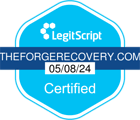Panic Disorder: Symptoms, Treatment Options, & Self-Help Tips


Panic disorder brings about intense feelings of fear and worry, driving symptoms that can feel like a heart attack. Living with this condition can be overwhelming and frankly exhausting, but thankfully, treatment is available in the form of psychotherapy and helpful medications. Learn more about the symptoms and treatment options for panic disorder, and contact The Forge Recovery Center today if you or a loved one need help managing and overcoming these daunting symptoms.
What Is Panic Disorder?
Panic disorder is a type of anxiety disorder characterized by recurring and unexpected panic attacks. These attacks are intense periods of fear or discomfort that reach a peak within minutes. Symptoms can include heart palpitations, sweating, trembling, shortness of breath, and a feeling of impending doom.
People with panic disorder often worry about when the next attack will occur, and may avoid certain situations or places in an attempt to prevent them. Treatment typically involves therapy, medication, or a combination of both to help manage symptoms and improve quality of life.
Anxiety Attacks Vs. Panic Attacks
Anxiety attacks and panic attacks are often used interchangeably, but they have distinct differences. Anxiety attacks typically arise in response to a stressor or trigger, and the symptoms build up gradually. These symptoms may include feelings of worry, nervousness, and fear, along with physical manifestations like increased heart rate, sweating, and trembling. On the other hand, panic attacks come on suddenly and unexpectedly, reaching peak intensity within minutes.
On the other hand, symptoms of a panic attack may include a sense of impending doom, chest pain, shortness of breath, dizziness, and a feeling of being out of control. While both anxiety and panic attacks can be distressing, understanding their differences can help in identifying and managing them effectively.

Symptoms of Panic Disorder
Panic disorder carries a set of psychological and physical symptoms that can starkly impact your day-to-day life and obligations. Here’s a roundup of the common symptoms associated with this condition:
Psychological Signs
Panic disorder can have profound psychological effects on individuals. You may experience overwhelming fear and anxiety, often feeling like you are losing control. These unexpected panic attacks can trigger an intense fear of death, making you believe that you are facing a life-threatening situation. As a result, you might start avoiding places or situations where previous panic attacks occurred, leading to further distress and limitations in daily life. This sense of fear and anxiety can be especially prevalent in late teens and early adulthood.
Physical Symptoms
During a panic attack, you may encounter various physical symptoms ranging from mild to severe. Common signs include a racing heart rate, shortness of breath, dizziness, and trembling. Sweating profusely and feeling nauseous are typical sensations experienced during these episodes. The array of physical symptoms can be overwhelming and contribute to the overall distress during panic attacks. These symptoms can sometimes be mistaken for a heart attack, causing further worry.
Impact on Daily Life
The impact of panic disorder on your daily activities can be significant. Fear of experiencing panic attacks can lead to avoidance behaviors, affecting your ability to engage in routine tasks or social settings. This constant worry about when the next attack might occur can disrupt your daily life, causing challenges in maintaining relationships and fulfilling work responsibilities. Social interactions may become daunting, and work performance could suffer due to the persistent fear and anxiety associated with panic disorder.
Remember, if you or someone you know is suffering from panic disorder, it’s important to seek help from a healthcare provider or mental health professional. They can provide information and support, and discuss treatment options, which may include psychotherapy, medicine, and self-care tips. It’s never too late to seek help and improve the quality of your life. It’s also beneficial to reach out to friends and family for support during this time.

Are You Struggling with Mental Health or Addiction?
We Can Help. Call Us Now!
CALL: 877-839-1772
Treatment for Panic Disorder
Treatment for panic disorder typically consists of psychotherapy, such as cognitive-behavioral or exposure therapy, as well as SSRI and SNRI medications. Let’s explore these treatment options further:
Therapy
CBT
Cognitive-behavioral therapy (CBT) is a common therapeutic approach for panic disorder. It targets changing negative thought patterns and behaviors that contribute to panic attacks. CBT is effective in teaching coping strategies during anxiety-inducing situations.
Exposure Therapy
Exposure therapy involves gradual exposure to feared objects or situations. This method helps individuals confront their fears and desensitize themselves. By facing triggers in a controlled environment, exposure therapy aids in reducing the intensity of panic responses over time.
Medication
SSRIs & SNRIs
Selective Serotonin Reuptake Inhibitors (SSRIs) and Serotonin-Norepinephrine Reuptake Inhibitors (SNRIs) are commonly prescribed medications for panic disorder. These drugs work by increasing serotonin levels in the brain, helping to alleviate symptoms of anxiety and panic attacks.
Benzodiazepines
Benzodiazepines are fast-acting medications used to provide immediate relief during a panic attack. While effective in the short term, there is a risk of developing tolerance and dependence with prolonged use. Benzodiazepines should be used cautiously under medical supervision.
Treatment Centers
Seeking help from inpatient or outpatient treatment centers specializing in anxiety disorders can greatly benefit those with panic disorder. These centers offer access to specialized professionals, including therapists and psychiatrists, who understand the complexities of panic disorder. Comprehensive treatment programs available at these centers encompass various therapeutic approaches tailored to individual needs.
What Causes Panic Disorder?
Panic disorder can be caused by a combination of genetic predisposition and environmental factors, such as stressful life events or trauma. Individuals with a family history of anxiety disorders may be more likely to develop panic disorder due to genetic influences. Here’s a quick overview of the typical causes of panic disorder:
Genetic Predisposition
Genetic factors play a significant role in the development of panic disorder. Family history can increase your susceptibility to experiencing panic attacks. Having a close relative with the disorder raises your risk significantly.
Stressful Events
Stressful life events can act as triggers for panic attacks. The relationship between stress and panic disorder is crucial to understand. Managing stress effectively is key to preventing panic episodes.
Triggers
Common triggers for panic attacks include situations like public speaking, enclosed spaces, or heights. Specific stimuli, such as loud noises, can also induce panic. Recognizing and managing these triggers is essential in dealing with panic disorder.
Are You Struggling with Mental Health or Addiction?
We Can Help. Call Us Now!
CALL: 877-839-1772
Is Panic Disorder Curable?
Panic disorder is a treatable condition, but it is not necessarily curable in the traditional sense. With appropriate treatment, many individuals with panic disorder can experience significant improvement in their symptoms and quality of life. Treatment options typically include therapy, such as cognitive-behavioral therapy (CBT) or exposure therapy, as well as medications like selective serotonin reuptake inhibitors (SSRIs) or benzodiazepines.
It's important for individuals with panic disorder to work closely with mental health professionals to develop a personalized treatment plan that addresses their specific needs and goals. While some individuals may continue to experience occasional symptoms even with treatment, the goal is usually to manage and reduce the frequency and severity of panic attacks rather than completely eliminate them. With ongoing support and effective treatment, many people with panic disorder can lead fulfilling and productive lives.

Self-Help Strategies
Treatment for panic disorder doesn’t stop once you’re home. In order to sustain any progress gained through therapy and treatment, it’s important to care for yourself and take certain measures. Here are some self-help tactics to keep you on track:
Relaxation Techniques
When experiencing panic disorder, utilizing relaxation techniques can significantly aid in managing symptoms. By practicing techniques such as mindfulness and deep breathing, you can effectively reduce anxiety levels. Mindfulness helps you stay present and focused, diverting your mind from anxious thoughts. Deep breathing slows down your heart rate and promotes a sense of calmness during panic attacks.
Healthy Lifestyle Choices
In managing panic disorder, the impact of healthy lifestyle choices cannot be overstated. Engaging in regular exercise not only improves physical health but also plays a crucial role in reducing anxiety levels. Maintaining a diet rich in essential nutrients contributes to overall well-being and aids in managing panic attacks effectively. Furthermore, ensuring you get adequate sleep is vital for regulating emotions and decreasing anxiety levels.
Are You Struggling with Mental Health or Addiction?
We Can Help. Call Us Now!
CALL: 877-839-1772
Seeking Treatment for Panic Disorder
If you’re ready to start therapy and treatment for panic disorder, it starts with reaching out to a mental health professional or a trusted mental health and addiction treatment center. It’s also important to ensure that you have a solid support system in place while in treatment to keep you motivated throughout the process. Here are your next steps as someone seeking professional support in managing panic disorder:
Mental Health Professionals
Mental health professionals play a pivotal role in treating panic disorder. Therapists and psychiatrists are equipped to offer effective care and support. Establishing a supportive relationship with these professionals can enhance your treatment outcomes.
Therapists employ various techniques such as cognitive-behavioral therapy (CBT) to address panic disorder symptoms. Psychiatrists may prescribe medication when necessary, ensuring a holistic approach to your mental health.
Mental Health & Addiction Treatment Centers
Mental health and addiction treatment centers provide comprehensive care for individuals with panic disorder. These centers offer an integrated approach to treating co-occurring disorders, addressing both mental health issues and addiction simultaneously.
Specialized treatment programs in dual diagnosis cases cater to the unique needs of individuals struggling with both panic disorder and addiction. This targeted approach ensures that you receive tailored care for your specific challenges.
Role of Support Systems
Support systems are essential in managing panic disorder effectively. Family and friends can offer emotional support, understanding, and encouragement during challenging times. Their presence can make a significant difference in your recovery journey.
Engaging with support groups allows you to connect with others who are facing similar challenges. Sharing experiences, coping strategies, and successes with peers can provide a sense of belonging and reduce feelings of isolation.

Panic Disorder Prevalence
Panic disorder affects approximately 2-3% of people in the U.S., making it fairly a common mental health condition. It often emerges during late adolescence or early adulthood. Worldwide, studies have reported lifetime prevalence rates of around 13%.
Panic attacks, a hallmark of panic disorder, can strike unexpectedly and repeatedly. On average, individuals may experience around 1-2 panic attacks per month, but this varies depending on the severity of the condition. These episodes can be debilitating and overwhelming.
Are You Struggling with Mental Health or Addiction?
We Can Help. Call Us Now!
CALL: 877-839-1772
Closing Thoughts
Now that you understand panic disorder, its symptoms, treatments, causes, and self-help strategies, you are equipped to make informed decisions about seeking help. Remember, panic disorder is manageable with the right support. By recognizing the signs early on and exploring various treatment options, you can regain control over your life and well-being.
Don't hesitate to reach out to a mental health professional if you or someone you know is experiencing symptoms of panic disorder. Seeking help is not a sign of weakness but a proactive step towards better mental health. Remember, you are not alone in this journey toward healing and recovery. Your well-being matters, so take the first step today to prioritize your mental health.
Panic Disorder: Treatment for Panic Attacks in Orange County
Living with panic disorder is draining and overwhelming. We understand the distress and fear that these symptoms can cause, but remember — you’re not alone in this journey, and help is available. At The Forge Recovery Center, we have a dedicated team of mental health professionals ready to support you. We also offer a range of therapies tailored to help you regain control and alleviate the symptoms characteristic of panic disorder.
If you or a loved one is struggling with panic disorder, we urge you to reach out to us. There’s no need to face this alone, and with the right support, you can navigate this journey towards recovery. Explore our treatment modalities below, and call us today to get the support you deserve.
Treatment Modalities We Offer
At The Forge Recovery Center, we use a range of proven treatment modalities to support your path to healing:
Case Management
Our experts steer clients towards resources that support recovery, evaluating personal risks to formulate a thorough treatment plan.
CBT
CBT aids clients in altering negative thought cycles and behaviors associated with drug addiction, with the goal of preventing relapse and promoting a drug-free lifestyle.
DBT
DBT aids those grappling with emotional instability from substance abuse, promoting emotional control and positive life alterations.
EMDR
EMDR enables clients to process trauma that may contribute to their addiction, utilizing eye movement techniques to lessen psychological distress.
Experiential
Experiential therapy rekindles life’s pleasures and confronts the root trauma of addictive behaviors through engaging in therapeutic activities.
Family Counseling
Family therapy strengthens family bonds and nurtures a supportive network crucial for sustained recovery and abstinence.
Group Therapy
Group therapy offers a communal space for support, enhancing recovery through the exchange of stories and collective resilience.
Individual Therapy
Tailored individual therapy sessions focus on the distinct challenges each client faces, assisting their journey towards a life free of substances.
MAT
MAT merges approved medications with counseling to effectively tackle addiction, alleviating withdrawal symptoms and minimizing the risk of relapse.
TMS
TMS, a non-invasive technique, employs magnetic fields to stimulate the brain, aiding in the reduction of intense drug cravings.
Motivational Interviewing
Motivational interviewing drives clients to make healthier decisions, such as overcoming cocaine addiction, by cultivating a sense of self-belief.
Trauma-Informed Care
Acknowledging trauma’s influence on addiction, trauma-informed care is demonstrated to be effective in guiding clients through treatment and comprehending its impact on their psychological and emotional well-being.


